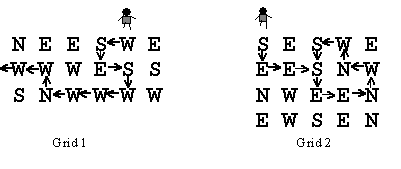POJ 1573 Robot Motion【是搜尋,就不要糾結是DFS還是BFS】
阿新 • • 發佈:2019-02-12
Robot Motion

A robot has been programmed to follow the instructions in its path. Instructions for the next direction the robot is to move are laid down in a grid. The possible instructions are
N north (up the page)
S south (down the page)
E east (to the right on the page)
W west (to the left on the page)
For example, suppose the robot starts on the north (top) side of Grid 1 and starts south (down). The path the robot follows is shown. The robot goes through 10 instructions in the grid before leaving the grid.
Compare what happens in Grid 2: the robot goes through 3 instructions only once, and then starts a loop through 8 instructions, and never exits.
You are to write a program that determines how long it takes a robot to get out of the grid or how the robot loops around.
| Time Limit: 1000MS | Memory Limit: 10000K |
| Total Submissions: 12845 | Accepted: 6234 |
Description

A robot has been programmed to follow the instructions in its path. Instructions for the next direction the robot is to move are laid down in a grid. The possible instructions are
N north (up the page)
S south (down the page)
E east (to the right on the page)
W west (to the left on the page)
For example, suppose the robot starts on the north (top) side of Grid 1 and starts south (down). The path the robot follows is shown. The robot goes through 10 instructions in the grid before leaving the grid.
Compare what happens in Grid 2: the robot goes through 3 instructions only once, and then starts a loop through 8 instructions, and never exits.
You are to write a program that determines how long it takes a robot to get out of the grid or how the robot loops around.
Input
Output
Sample Input
3 6 5 NEESWE WWWESS SNWWWW 4 5 1 SESWE EESNW NWEEN EWSEN 0 0 0
Sample Output
10 step(s) to exit 3 step(s) before a loop of 8 step(s)
Source
題意:有一個N*M的區域,機器人從第一行的第幾列進入,該區域全部由'N' , 'S' , 'W' , 'E' ,走到某個區域的時候只能按照該區域指定的方向進行下一步,問你機器人能否走出該片區域,若不能,輸入開始繞圈的步數和圈的大小。
DFS還是BFS對於這題有影響嗎?
對,有,BFS 0ms!!DFS 16 ms!!!
搜尋我是渣渣,看兩份到嗎的資料,POJ。
BFS AC程式碼:
#include <iostream>
#include <cstdio>
#include <cstring>
#include <queue>
using namespace std;
struct node
{
int x,y;
node(int x=0,int y=0):x(x),y(y) {};
//裝X的寫法
};
char a[15][15];
bool vis[15][15];
int step[15][15];
int n,m,s;
void BFS()
{
queue<node>q;
memset(vis,false,sizeof(vis));
step[0][s-1]=0;
q.push(node(0,s-1));
int stepp=-1;
while(!q.empty())
{
node now=q.front();
q.pop();
stepp++;
if(now.x<0||now.x>=n||now.y<0||now.y>=m)
{
printf("%d step(s) to exit\n",stepp);
return ;
}
if(vis[now.x][now.y])
{
printf("%d step(s) before a loop of %d step(s)\n",step[now.x][now.y],stepp-step[now.x][now.y]);
return ;
}
vis[now.x][now.y]=true;
step[now.x][now.y]=stepp;
if(a[now.x][now.y]=='S')
{
q.push(node(now.x+1,now.y));
}
else if(a[now.x][now.y]=='N')
{
q.push(node(now.x-1,now.y));
}
else if(a[now.x][now.y]=='W')
{
q.push(node(now.x,now.y-1));
}
else if(a[now.x][now.y]=='E')
{
q.push(node(now.x,now.y+1));
}
}
}
int main()
{
while(cin>>n>>m>>s,n,m,s)
{
for(int i=0; i<n; i++)
cin>>a[i];
BFS();
}
return 0;
}
/**
3 3 1
SWW
SSN
EEN
*/
DFS AC程式碼:15ms
#include <iostream>
#include <cstdio>
#include <cstring>
using namespace std;
char a[15][15];
bool vis[15][15];
int step[15][15];
int n,m,s,stepp;
void DFS(int x,int y,int t)
{
stepp++;
if(x<0||x>=n||y<0||y>=m)
{
printf("%d step(s) to exit\n",stepp);
return ;
}
if(vis[x][y])
{
printf("%d step(s) before a loop of %d step(s)\n",step[x][y],stepp-step[x][y]);
return ;
}
vis[x][y]=true;
step[x][y]=stepp;
int xx,yy;
if(a[x][y]=='S')
{
//x+=1;
xx=x+1;
yy=y;
}
else if(a[x][y]=='N')
{
//x-=1
xx=x-1;
yy=y;
}
else if(a[x][y]=='W')
{
//y-=1;
xx=x;
yy=y-1;
}
else if(a[x][y]=='E')
{
//y+=1;
xx=x;
yy=y+1;
}
DFS(xx,yy,stepp+1);
}
int main()
{
while(cin>>n>>m>>s,n,m,s)
{
for(int i=0; i<n; i++)
cin>>a[i];
stepp=-1;
memset(vis,false,sizeof(vis));
DFS(0,s-1,0);
}
return 0;
}

